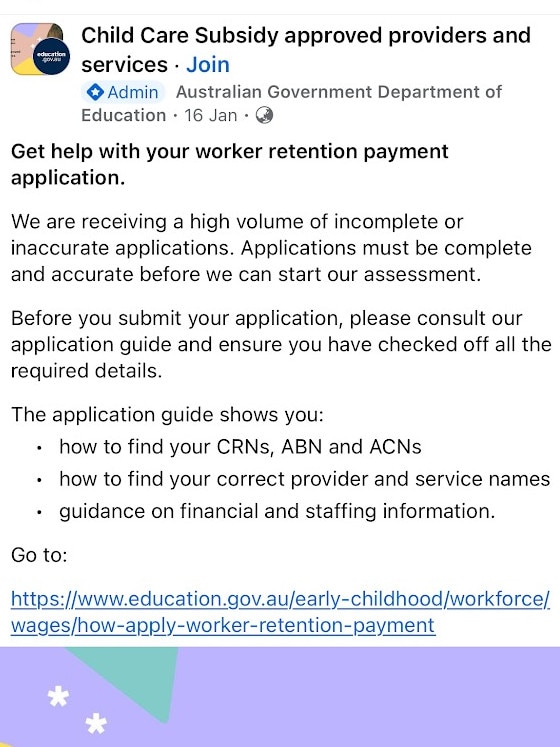‘Your grant is a joke’: Daycare owners spit the dummy over red tape for $3.6bn in taxpayer grants
On-the-run changes to the federal Education Department’s grant guidelines have left 85 per cent of the nation’s childcare workers without their promised $100 a week pay rise.

On-the-run changes to the federal Education Department’s Byzantine grant guidelines have left 85 per cent of the nation’s childcare workers without their promised $100 a week pay rise.
Some small daycare owners – who operate 80 per cent of services – have spat the dummy over the red tape attached to $3.6bn in taxpayer grants.
Employers can use the money to cover a 10 per cent pay rise for 200,000 childcare workers, due last month, with another 5 per cent increase at the end of this year, in return for capping fee increases to 4.4 per cent.
Some operators have opted to ignore the grant and pay staff by jacking up their fees – undermining the Albanese government’s cost-of-living initiative to keep a lid on fees in an election year.
Only 1530 of the nation’s 11,300 childcare businesses have applied for the Commonwealth cash. Mostly large and medium-sized operators, the applicants own 7400 of the nation’s 14,000 long daycare centres.
A departmental spokeswoman said: “About 51 per cent of eligible services have submitted applications for the worker retention payment. An estimated 31,000 early childhood education and care workers are employed by services that have been approved for the payment.’’
The department has told applicants they must wait up to two months for a decision.
Eighteen public servants are working as administrators for a departmental Facebook page set up to connect with childcare operators. In a post last week, the department triggered a dummy spit from angry operators when it complained about the quality of applications.
“We are receiving a high volume of incomplete or inaccurate applications,’’ the department stated.

“Before you submit your application, please consult our application guide and ensure you have checked off all the required details.’’
The department posted a link to an eight-page “summary’’ document, which linked to a 32-page guideline document that could be read only after registering for and logging in to the Grant Connect website.
One daycare owner responded that she had decided to “put our fees up and give our educators the pay rise that way”.
“Your grant is a joke,’’ she wrote. “It has taken us 2 admin staff 3 x 8 hour days to do the working out to determine whether or not it is worth it.
“You aren’t going to give services enough money to cover the expense and in 2027 they will all be putting their fees up drastically to cover what you aren’t paying for anymore.
“These paper pushers have no idea how services actually operate and are making decisions for us that they have no clue about.’’
Another centre owner responded: “I will not be opting in either, but trying to keep it fair for families and not send myself broke at the same time.’’
A third operator described the grant as “an absolute joke’’.
“After spending months of time and money liaising with our accountant and solicitor, we applied in early December to know exactly what we would get before deciding whether to opt in,’’ she wrote.
“We are still waiting for a response; meanwhile our staff and our families are in limbo not knowing whether we need to increase fees or not.
“You wonder why staff are leaving – it’s because compliance has gone through the roof and every program or initiative that is introduced by federal or state governments are having to be administered by the services, taking the experienced and most qualified people further away from the children.’’
The Education Department has issued dozens of amendments and updates since issuing the first grant guidelines last November.

Another daycare provider noted that the department’s complaint about incomplete or inaccurate applications “is simply a reflection of a system that is complicated to understand and has been rolled out too fast without proper thought and consultation’’.
One queried how large operators – including childcare giants Goodstart Early Learning, and the ASX-listed G8 Education group – had managed to get their grants approved “so quickly”.
Goodstart, whose chief executive Ros Baxter was previously deputy secretary of the Department of Education, delivered a 10 per cent pay rise to its 17,000 teachers, educators, cooks and administrative assistants on the first day of the grant program, December 2.
G8 has also passed on the money to nearly 10,000 workers.
Anthony Albanese declared on December 11 that 200,000 early educators would get a 10 per cent pay rise “from this month, and another 5 per cent on top, next year’’.
“For someone earning the award rate, that’s an increase of over $100 a week right now – and increasing to $150 a week next year,’’ the Prime Minister told attendees at Labor’s childcare policy launch in Brisbane.
Goodstart and G8 were the first operators to sign on to a multi-employer bargaining agreement, which can be used to meet the Education Department’s grant requirement of a “workplace instrument’’.
The Fair Work Commission will hear an application on Friday for six more childcare chains, as well as 2600 small providers, to join the agreement so they can apply for the government grant.
The companies include C&K, Edge, Affinity, Guardian, Nido, Busy Bees, and Stepping Stone.
If approved by the FWC, the multi-employer agreement will make 48,700 childcare workers – a quarter of the workforce – eligible for the pay rise.
Federal Education Minister Jason Clare said on Thursday his department had changed its grant guidelines to make it easier to apply.
He said the pay rise was helping to retain existing educators and attract new workers to the sector.
“We are already seeing a welcome drop in vacancies,’’ he said.
The latest Jobs and Skills Australia vacancy data reveals a 22 per cent drop in childcare staff vacancies in the wake of the pay rise promise.
Vacancies fell from 7721 unfilled jobs in December 2023 to 6013 last month.
ACTU secretary Sally McManus said many workers were struggling to survive on a $45,000 a year wage.







To join the conversation, please log in. Don't have an account? Register
Join the conversation, you are commenting as Logout